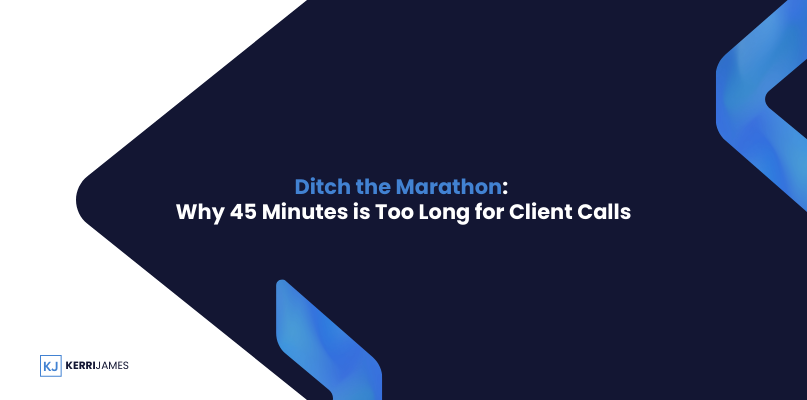In today’s fast-paced, information-saturated world, time is a precious commodity, especially for potential clients seeking legal help. They’re often juggling work, family, and the emotional strain of their legal issue. While a thorough and informative intake process is undeniably essential for any law firm, clinging to the traditional model of lengthy initial consultations, often stretching to 45 minutes or more, can be a detriment to both your firm’s efficiency and your clients’ experience.
Imagine yourself in their shoes: a potential client, their nerves already frayed by a recent accident, a family dispute, or a business conflict. They finally summon the courage to call your firm, seeking guidance, reassurance, and a glimmer of hope in a confusing and stressful situation. Instead of a compassionate and efficient welcome, they’re met with a barrage of questions, legal jargon, and a seemingly endless intake process that feels more like an interrogation than a conversation. This approach can leave them feeling even more overwhelmed and disillusioned, pushing them to seek help elsewhere.
This is where the concept of a shorter, more focused initial consultation becomes a strategic advantage. By shifting from marathon calls to strategic conversations, you can create a more efficient, engaging, and ultimately more client-centric approach. It’s about recognizing that the first call is not the time to delve into the intricate details of their case; it’s about building rapport, assessing their needs, and securing their commitment to move forward with your firm. It’s about demonstrating empathy, building trust, and making them feel like a valued individual, not just another case file.
Section 1: The Problem With Long Intake Calls: Information Overload, Reduced Engagement, and Missed Opportunities
While the intention behind a long intake call might be admirable – to gather as much information as possible from the outset – this approach often backfires, creating a negative experience for the client and hindering your firm’s ability to convert leads into paying clients.
Here’s a closer look at why long intake calls can be counterproductive:
1.1: Information Overload: Drowning Clients in Details:
When clients are bombarded with a lengthy intake process, their brains go into overload mode. They’re trying to process a stressful situation, understand complex legal concepts, and remember specific details, all while navigating the emotional rollercoaster that often accompanies legal issues. This cognitive overload can lead to:
- Inaccurate or incomplete information: Clients might forget crucial details, misinterpret questions, or simply provide inaccurate information due to stress and confusion.
- Missed opportunities to identify key case details: Important nuances or crucial pieces of information might be overlooked in the rush to gather a large volume of data.
- A less effective representation: Incomplete or inaccurate information can hinder your ability to build a strong case and achieve the best possible outcome for your client.
1.2: Reduced Engagement and Conversion: Turning Clients Away with Lengthy Processes:
A long, drawn-out intake call can make clients feel like they’re being interrogated rather than listened to. Instead of feeling heard and understood, they feel like just another case file, a number in a queue. This impersonal experience can lead to:
- Disengagement and frustration: Clients might become disengaged from the conversation, their attention wandering as the call drags on.
- A lack of trust: Clients might feel hesitant to share sensitive information with a firm that seems more focused on gathering data than building a relationship.
- A lower conversion rate: Clients might be less likely to commit to a firm that doesn’t make them feel valued and understood from the outset. They may decide to shop around for other options that offer a more personalized and empathetic experience.
1.3: Inefficient Use of Time and Resources: Straining Staff and Limiting Potential:
Long intake calls tie up valuable staff time that could be better spent on other essential tasks, such as:
- Following up with leads: Nurturing potential clients and building relationships that lead to conversions.
- Preparing for client meetings: Ensuring that meetings are productive and focused on the client’s specific needs.
- Working on existing cases: Moving existing cases forward and achieving successful outcomes for current clients.
This inefficient use of resources can strain your team, limit your firm’s capacity to handle new cases, and ultimately, impact your bottom line.
Section 2: Benefits of a Shorter Initial Consultation: A Focused Approach for Better Results
Shifting to a shorter, more focused initial consultation, typically around 15-20 minutes, offers a range of benefits for both your firm and your clients, creating a more positive and productive experience for everyone involved.
Here’s how shorter consultations can transform your intake process:
2.1: More Manageable for Clients: Meeting Clients Where They Are:
A shorter consultation is less intimidating and more manageable for clients who are already feeling stressed and overwhelmed by their legal situation. It allows them to:
- Focus on the most important details: Without being bogged down by excessive information, clients can concentrate on sharing the essential elements of their case and understanding the next steps.
- Feel heard and understood: A shorter, more focused conversation allows for more personalized attention, making the client feel like their concerns are being taken seriously.
- Experience a sense of efficiency: A quick and efficient process can be reassuring for clients who are already feeling overwhelmed, demonstrating that you value their time and understand their need for swift action.
2.2: Increased Chance of Securing a Commitment: Momentum and Confidence:
A shorter consultation allows you to quickly:
- Establish rapport: A brief, engaging conversation can help create a connection with the client, making them feel comfortable and confident in your ability to help.
- Demonstrate your expertise: By focusing on the key elements of their case, you can quickly showcase your knowledge and experience in their specific area of law.
- Build trust: A concise and informative conversation can instill confidence in your firm’s capabilities, making the client more likely to trust your advice and recommendations.
This focused approach increases the likelihood of securing the client’s commitment on the spot, as they’ll feel more confident in your firm’s ability to help and less likely to shop around for other options.
2.3: Builds Rapport Without Overwhelming: Fostering Connection and Collaboration:
A shorter consultation allows for a more:
- Conversational approach: Instead of a one-sided interrogation, the conversation becomes a more natural back-and-forth exchange, fostering a sense of collaboration and partnership.
- Empathetic connection: A shorter time frame allows for a more focused and personalized conversation, allowing you to connect with the client on an emotional level and demonstrate empathy for their situation.
- Open dialogue: Clients are more likely to ask questions and engage in open communication when they feel comfortable and heard.
Section 3: How to Shorten Your Intake Process Without Losing Quality: Essential Questions, Efficient Information Gathering, and the Power of Onboarding
The key to shortening your intake process without sacrificing quality lies in a strategic three-part approach:
- Identify Essential Questions: Determine the key questions needed to assess the case, determine fit, and make an informed decision about representation.
- Streamline Information Gathering: Utilize tools and techniques to collect essential information quickly and efficiently.
- Reserve Detailed Casework for Onboarding: Schedule a dedicated onboarding session for a comprehensive review of documents, completion of paperwork, and in-depth discussion of the legal strategy.
Key Questions for the Initial Consultation: Determining Fit and Building a Foundation:
Focus on gathering the information needed to answer these three critical questions:
- Does the client have a valid case?
- Does the case align with your firm’s expertise?
- Is the client a good fit for your firm’s culture and communication style?
Here are some essential questions to guide the initial conversation:
- What is the nature of your legal issue? This open-ended question allows the client to explain their situation in their own words, providing valuable insight into their perspective, priorities, and emotional state.
- When did this occur? Understanding the timeline of events is crucial for determining if the case falls within the statute of limitations, for assessing the potential strength of the claim, and for identifying any potential issues with evidence or witness testimony.
- Were you injured? If so, what are the nature and extent of your injuries? This information is essential for personal injury cases, as it helps determine the potential value of the claim and the appropriate legal strategy.
- Do you have insurance? If so, what type of coverage do you have? Understanding the client’s insurance coverage is crucial for determining potential sources of recovery and developing a strategy for dealing with insurance adjusters.
- Have you spoken to any other lawyers about this case? This question helps you understand the client’s journey so far and if they’ve already explored other legal options. It also allows you to address any concerns or misconceptions they might have based on their previous experiences.
Efficient Information Gathering Techniques: Streamlining the Process Without Sacrificing Detail:
- Use a structured intake form. A well-designed intake form, whether online or in print, can help you gather essential information quickly and efficiently, ensuring that you don’t miss any key details. Consider using online forms that clients can fill out in advance, saving time during the phone consultation and allowing them to provide information at their own pace.
- Prioritize active listening. Pay close attention to the client’s responses, asking clarifying questions as needed to ensure you fully understand their situation. Active listening not only helps you gather accurate information but also demonstrates empathy and builds rapport, making the client feel heard and valued.
- Focus on the “must-haves.” Identify the information that’s absolutely essential for making an initial assessment of the case and focus on gathering those details during the initial call. Leave the more detailed casework, such as reviewing documents, contacting witnesses, or researching specific legal precedents, for the onboarding process.
Leaving the Details for Onboarding: The Power of a Two-Part Process
Once you’ve determined that the client has a potential case and that it’s a good fit for your firm, schedule a dedicated onboarding session to delve into the specifics. This dedicated time allows you to:
- Gather detailed information: Review any relevant documents, such as police reports, medical records, contracts, photographs, or other evidence.
- Complete necessary paperwork: Guide the client through any required forms, such as retainer agreements, fee agreements, medical release forms, or authorizations for release of information.
- Discuss the legal strategy in depth: Explain the legal process, potential challenges, expected timelines, and the roles and responsibilities of both the client and the legal team, ensuring the client fully understands the path forward.
This two-part approach allows you to:
- Secure the client’s commitment quickly and efficiently during the initial consultation, capturing their interest while they’re actively seeking legal help.
- Provide a thorough and comprehensive onboarding process that addresses all the necessary details without overwhelming the client during the first interaction.
- Create a positive and structured client journey that fosters trust, clarity, and confidence throughout the legal process.
Section 4: The Role of Follow-Up in Maintaining Client Engagement: Building Relationships Through Consistent Communication
Shortening the initial consultation doesn’t mean neglecting follow-up. In fact, a well-structured and personalized follow-up process is crucial for maintaining client engagement, building trust, and ultimately, converting leads into long-term clients who feel valued and appreciated.
4.1: Strategies for Effective Follow-Up Communication:
Immediate Follow-Up: Reinforcing the Connection and Setting Expectations: Send a personalized email or text message within minutes of the initial call, thanking the client for their time, reiterating the next steps, and providing contact information for any questions they may have. This immediate follow-up shows that you’re responsive and attentive to their needs, reinforcing their decision to contact your firm and setting a positive tone for the relationship.
Scheduled Communication: Keeping Clients Informed and Engaged: Set up a system for scheduled follow-up communication, such as emails or phone calls, to keep the client informed of the progress on their case. This could include:
- Regular updates on case developments: Sharing any new information, court filings, or correspondence related to their case.
- Answers to any questions or concerns: Addressing any anxieties or uncertainties the client may have.
- Reassurance that their case is moving forward: Providing a sense of progress and momentum, which can be incredibly reassuring for clients navigating a complex legal process.
This consistent communication helps build trust, minimizes anxiety, and reinforces the client’s decision to choose your firm.
Personalized Content: Demonstrating Expertise and Providing Value: Share relevant articles, blog posts, or videos that address the client’s specific legal issue. This demonstrates your expertise, provides valuable information that helps them understand their situation, and keeps your firm top-of-mind, establishing you as a trusted resource.
Client Portal Access: Empowering Clients Through Transparency and Control: If your firm utilizes a client portal, provide the client with access as soon as possible. This secure platform allows them to:
- Access case updates 24/7: Stay informed about the progress of their case on their own time, reducing anxiety and providing a sense of control.
- Share documents securely: Easily upload and share any relevant documents with their legal team, streamlining the process and ensuring that everyone has access to the most up-to-date information.
- Communicate with their legal team: Send messages, ask questions, and receive prompt responses, fostering open communication and building a collaborative relationship.
This level of access and control fosters a sense of transparency, empowerment, and active participation in their case, enhancing client satisfaction and strengthening the attorney-client relationship.
4.2: Benefits of Structured Follow-Up: Beyond Conversion to Lasting Relationships
- Improved Conversion Rates: Consistent and personalized follow-up communication demonstrates your commitment to the client’s case, increasing the likelihood that they’ll move forward with your firm and sign a formal representation agreement. It shows that you’re invested in their well-being and dedicated to achieving the best possible outcome.
- Enhanced Client Experience: Regular updates, informative content, and readily accessible channels of communication keep the client informed and engaged throughout the process, reducing anxiety, building trust, and creating a positive experience that extends beyond the legal outcome. It’s about making the client feel valued, supported, and empowered throughout their legal journey.
- Increased Client Retention: Clients who feel valued and appreciated, who feel heard and understood, are more likely to remain loyal to your firm and recommend your services to others. A strong follow-up process is an investment in long-term relationships, turning new clients into raving fans who become valuable sources of referrals and contribute to your firm’s reputation and growth.
The Verdict: Shifting From Marathon Calls to Focused Conversations and Consistent Follow-Up
In today’s competitive legal landscape, client experience is paramount. By shifting from marathon intake calls to shorter, more focused consultations followed by structured and personalized follow-up communication, you can create a more efficient, engaging, and ultimately more client-centric approach.
This strategy not only benefits your clients by providing a more manageable and less stressful experience, but it also enhances your firm’s efficiency and profitability by:
- Increasing conversion rates: Capturing leads more effectively and turning them into paying clients.
- Fostering long-term client relationships: Building trust and loyalty, leading to repeat business and valuable referrals.
- Optimizing your team’s time and resources: Allowing your staff to focus on high-value tasks, improving overall productivity and efficiency.
It’s about recognizing that time is valuable, both for your firm and your clients, and utilizing that time strategically to create a win-win situation for everyone involved.










